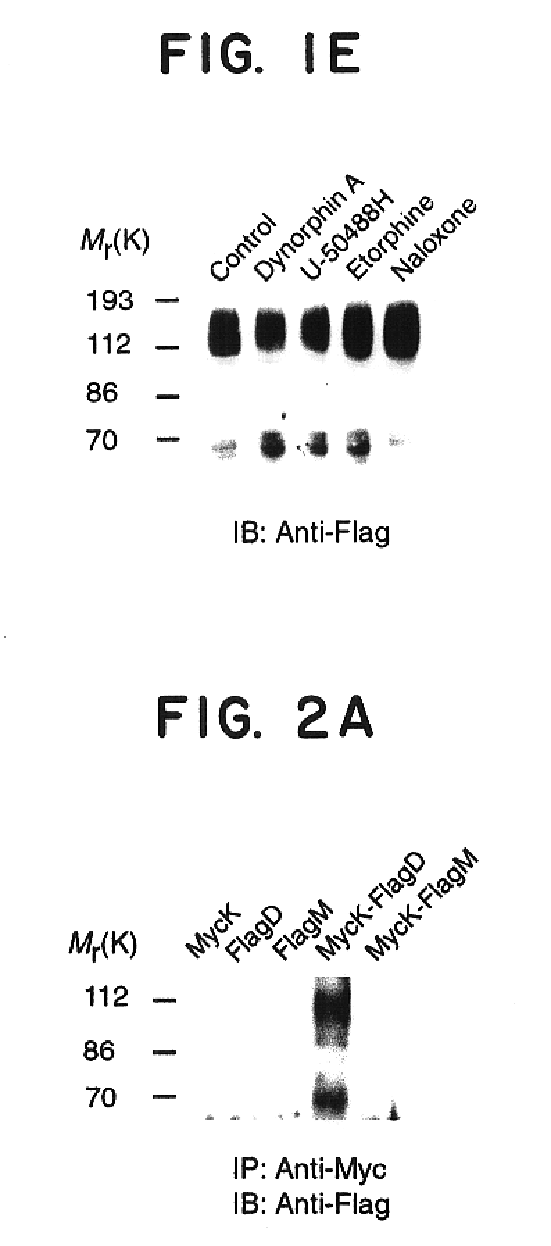Heterodimeric opioid G-protein coupled receptors
a technology of g-protein coupled receptors and heterodimers, which is applied in the field of heterodimer opioid receptors, can solve the problems of hampered efforts to identify more effective opioid agonists, insufficient functional evidence supporting the existence of this confusing number of putative subtypes of -receptors, and ineffective treatment of cardiovascular diseases, so as to achieve precise identification of receptors, inhibit hiv infection, and effective treatment of cardiovascular diseases
- Summary
- Abstract
- Description
- Claims
- Application Information
AI Technical Summary
Benefits of technology
Problems solved by technology
Method used
Image
Examples
example 1
Determination If Opioid Receptor Heterodimerization Modulates Receptor Function
This example provides biochemical and pharmacological evidence for the heterodimerization of two fully functional opioid receptors (kappa and delta), as well as evidence for covalent homodimerization of kappa receptor. This results in a new receptor that exhibits ligand binding and functional properties that are distinct from those of either receptor. Furthermore, the kappa-delta heterodimer synergistically binds highly selective agonists and potentiates signal transduction. Thus heterodimerization of these GPCRs represents a novel mechanism that modulates their function.
Materials and Methods
Abbreviations:
DTT, dithiothreitol; β-ME, 2-mercaptoethanol; IAM, iodoacetamide; NEM, n-ethylmaleimide.
Generation of Cell Lines Expressing Opioid Receptors.
Cells stably expressing epitope-tagged rat kappa or mouse delta receptors were generated as described previously (Cvejic et al., J. Biol. Chem., 271:4073-4076, 1996...
example 2
Heterodimerization of Mu and Delta Opioid Receptors. A Novel Super High Affinity Morphine Binding Site Uncovered by Opiate Synergy
Materials and Methods
Generation of Cell Lines Expressing Opioid Receptors and Isolation of Receptor Heterodimers by Immunoprecipitation.
Cells expressing mu-delta receptors were generated by transfecting HEK-293 cells or CHO cells with FLAG-tagged mouse mu receptor cDNA and myc-tagged delta receptor cDNA using standard calcium phosphate precipitation. In the majority of the studies, the mu:delta receptor ratio for HEK cells was approximately 1:3 and for CHO cells was 3:1. HEK-293 cells transiently transfected with tagged opioid receptor were lysed in buffer Tx / G (300 mM NaCl, 1% Triton X-100, 10% glycerol, 1.5 mM MgCl2, and 1 mM CaCl2 in 50 mM Tris-Cl, pH 7.4), containing a protease inhibitor cocktail and 10-100 mM iodoacetamide for 1 h at 4° C. The protease inhibitor cocktail contained 10 μg / ml leupeptin, 10 μg / ml aprotinin, 10 mM EDTA, 1 mM EGTA, 10 μg / m...
example 3
Heterodimerization of Kappa and Delta Opioid Receptors with Catecholamine Receptors
This example presents data that show that kappa receptors heterodimerize with β2-adrenergic and D2 dopamine receptors, and that delta receptors heterodimerize with mu opioid, β2-adrenergic, and D2 dopamine receptors.
Materials and Methods
Generation of cell lines expressing opioid receptors.
The rat kappa opioid receptor cDNA, mouse delta, or mouse mu receptor cDNA were tagged with either a FLAG epitope or a myc epitope by an overlapping extension polymerase chain reaction and subcloned into pCDNA-3 (Invitrogen). Human FLAG-tagged β2-adrenergic receptor or D2 dopamine receptor cDNAs were obtained from Dr. J. Jaritch (Columbia University) and HA-tagged α2-adrenergic receptors were obtained from Dr. L. Limberd (Vanderbilt University). Cells expressing delta plus mu, kappa plus β2, kappa plus D2, delta plus β2 and delta plus D2 receptors were generated by transfecting either HEK293 or COS cells (for transie...
PUM
| Property | Measurement | Unit |
|---|---|---|
| melting temperature | aaaaa | aaaaa |
| Tm | aaaaa | aaaaa |
| Tm | aaaaa | aaaaa |
Abstract
Description
Claims
Application Information
 Login to View More
Login to View More - R&D
- Intellectual Property
- Life Sciences
- Materials
- Tech Scout
- Unparalleled Data Quality
- Higher Quality Content
- 60% Fewer Hallucinations
Browse by: Latest US Patents, China's latest patents, Technical Efficacy Thesaurus, Application Domain, Technology Topic, Popular Technical Reports.
© 2025 PatSnap. All rights reserved.Legal|Privacy policy|Modern Slavery Act Transparency Statement|Sitemap|About US| Contact US: help@patsnap.com



